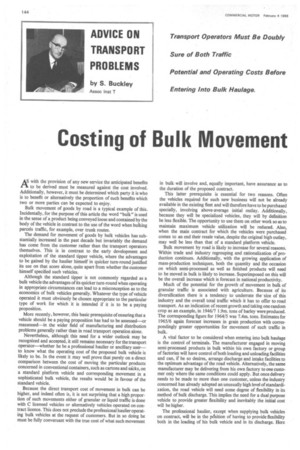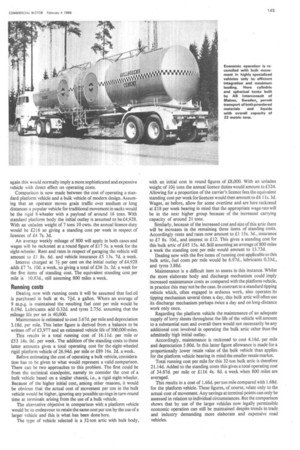Costing of Bulk Movement
Page 146

Page 147

If you've noticed an error in this article please click here to report it so we can fix it.
by S. Buckley
Assoc Inst T
Awith the provision of any new service the anticipated benefits to be derived must be measured against the cost involved. Additionally, however, it must be determined which party it is who is to benefit or alternatively the proportion of such benefits which two or more parties can be expected to enjoy.
Bulk movement of goods by road is a typical example of this. Incidentally, for the purpose of this article the word "bulk" is used in the sense of a product being conveyed loose and contained by the body of the vehicle in contrast to the use of the word when bulking parcels traffic, for example, over trunk routes.
The demand for movement of goods by bulk vehicles has substantially increased in the past decade but invariably the demand has come from the customer rather than the transport operators themselves. This is in contrast to the early development and exploitation of the standard tipper vehicle, where the advantages to be gained by the haulier himself in quicker turn-round justified its use on that score alone, quite apart from whether the customer himself specified such vehicles.
Although the standard tipper is not commonly regarded as a bulk vehicle the advantages of its quicker turn-round when operating in appropriate circumstances can lead to a misconception as to the economics of bulk vehicles generally. Whatever the type of vehicle operated it must obviously be chosen appropriate to the particular type of work for which it is intended if it is to be a paying proposition.
More recently, however, this basic prerequisite of ensuring that a vehicle should be a paying proposition has had to be assessed—or reassessed—in the wider field of manufacturing and distribution problems generally rather than in road transport operation alone.
Nevertheless, although this need for a wider outlook may be recognized and accepted, it still remains necessary for the transport operator—whether he be a professional haulier or ancillary user— to know what the operating cost of the proposed bulk vehicle is likely to be. In the event it may well prove that purely on a direct comparison between the cost of moving the particular products concerned in conventional containers, such as cartons and sacks, on a standard platform vehicle and corresponding movement in a sophisticated bulk vehicle, the results would be in favour of the standard vehicle.
Because the direct transport cost of movement in bulk can be higher, and indeed often is, it is not surprising that a high proportion of such movements either of granular or liquid traffic is done with C licensed vehicles or alternatively vehicles operated on contract licence. This does not preclude the professional haulier operating bulk vehicles at the request of customers. But in so doing he must be fully conversant with the true cost of what such movement in bulk will involve and, equally important, have assurance as to the duration of the proposed contract.
This latter prerequisite is essential for two reasons. Often the vehicles required for such new business will not be already available in the existing fleet and will therefore have to be purchased specially, involving above-average initial outlay. Additionally, because they will be specialized vehicles, they will by definition be less flexible. The opportunity to use them on other work so as to maintain maximum vehicle utilization will be reduced. Also, when the main contract for which the vehicles were purchased comes to an end their resale value, despite the original high outlay, may well be less than that of a standard platform vehicle.
Bulk movement by road is likely to increase for several reasons. Within trade and industry regrouping and rationalization of production continues. Additionally, with the growing application of mass-production techniques, both the quantity and the occasion on which semi-processed as well as finished products will need to be moved in bulk is likely to increase. Superimposed on this will be the overall increase which is forecast in national productivity.
Much of the potential for the growth of movement in bulk of granular traffic is associated with agriculture. Because of its diversification there is a tendency to underrate the size of this industry and the overall total traffic which it has to offer to road transport. As an indication of recent growth and taking one random crop as an example, in 1946/7 1.9m. tons of barley were produced. The corresponding figure for 1964/5 was 7.4m. tons. Estimates for 1965/6 again forecast increases in grain production with correspondingly greater opportunities for movement of such traffic in bulk.
A vital factor to be considered when entering into bulk haulage is the control of terminals. The manufacturer engaged in moving semi-processed products in bulk within his own factory or group of factories will have control of both loading and unloading facilities and can, if he so desires, arrange discharge and intake facilities to the optimum advantage of the road vehicle. Alternatively, the same manufacturer may be delivering from his own factory to one customer only where the same conditions could apply. But once delivery needs to be made to more than one customer, unless the industry concerned has already adopted an unusually high level of standardization, the road vehicle will need some degree of flexibility in its method of bulk discharge. This implies the need for a dual purpose vehicle to provide greater flexibility and inevitably the initial cost will be higher.
The professional haulier, except when supplying bulk vehicles on contract, will be in the Aldan of having to provide flexibility both in the loading of his bulk vehicle and in its discharge. Here again this would normally imply a more sophisticated and expensive vehicle with direct effect on operating costs.
Comparison is now made between the cost of operating a standard platform vehicle and a bulk vehicle of modern design. Assuming that an operator moves grain traffic over medium or long distances a popular vehicle for traditional movement in sacks would be the rigid 8-wheeler with a payload of around 16 tons. With standard platform body the initial outlay is assumed to be £4,928. With an unladen weight of 7 tons 10 cwts. the annual licence duty would be £216 so giving a standing cost per week in respect of licences of £4 7s. 3d.
An average weekly mileage of 800 will apply in both cases and wages will be reckoned at a round figure of £17 5s. a week for the eight-wheeler. Rent and rates in respect of garaging the vehicle will amount to £1 8s. 6d and vehicle insurance £5 13s. 7d. a week.
Interest charged at 7+ per cent on the initial outlay of £4,928 adds £7 7s. 10d. a week, so giving a total of £36 2s. 2d. a week for the five items of standing cost. The equivalent standing cost per mile is 10.83d., still assuming 800 miles a week.
Running costs Dealing now with running costs it will be assumed that fuel oil is purchased in bulk at 4s. 70. a gallon. Where an average of 9 m.p.g. is maintained the resulting fuel cost per mile would be 6.19d. Lubricants add 0.32d. and tyres 2.75d. assuming that the mileage life per set is 40,000.
Maintenance is estimated to cost 3.67d. per mile and depreciation 3.18d. per mile. This latter figure is derived from a balance to be written off of £3,977 and an estimated vehicle life of 300,000 miles.
This results in a total running cost of 16.11d. per mile or £53 14s. Od. per week. The addition of the standing costs to these latter amounts gives a total operating cost for the eight-wheeled rigid platform vehicle of 26.944. per mile or £89 16s. 2d. a week.
Before estimating the cost of operating a bulk vehicle, consideration has to be given to what would represent a valid comparison. There can be two approaches to this problem. The first could be from the technical standpoint, namely to consider the cost of a bulk vehicle based on a similar chassis, i.e., a rigid eight-wheeler. Because of the higher initial cost, among other reasons; it would be obvious that the actual cost of movement per ton in the bulk vehicle would be higher, ignoring any possible savings in turn-round time at terminals arising from the use of a bulk vehicle.
The alternative objective in comparison with a platform vehicle would be to endeavour to retain the same cost per ton by the use of a larger vehicle and this is what has been done here.
The type of vehicle selected is a 32-ton artic with bulk body, with an initial cost in round figures of £8,000. With an unladen weight of 10+ tons the annual licence duties would amount to £324. Allowing for a proportion of the carrier's licence fees the equivalent standing cost per week for licences would then amount to £6 lit s. 3d. Wages, as before, allow for some overtime and are here reckoned at £18 per week bearing in mind that the appropriate wage rate will be in the next higher group because of the increased carrying capacity of around 21 tons.
Similarly, because of the increased cost and size of this artic there will be increases in the remaining three items of standing costs. Accordingly rents and rates now amount to £1 15s. 3d., insurance to £7 8s. 10d., and interest to £12. This gives a standing cost for this bulk artic of £45 15s. 4d. Still assuming an average of 800 miles a week the standing cost per mile would amount to 13.734.
Dealing now with the five items of running cost applicable to this bulk artic, fuel costs per mile would be 6,97d., lubricants 0.33d., and tyres 3.884.
Maintenance is a difficult item to assess in this instance. Whilst the more elaborate body and discharge mechanism could imply increased maintenance costs as compared with the platform vehicle, in practice this may not be the case. In contrast to a standard tipping vehicle which, often engaged in arduous work, also operates its tipping mechanism several times a day, this bulk artic will often use its discharge mechanism perhaps twice a day and on long-distance work only once.
Regarding the platform vehicle the maintenance of an adequate supply of lorry sheets throughout the life of the vehicle will amount to a substantial sum and overall there would not necessarily be any additional cost involved in operating the bulk artic other than the admittedly high initial outlay.
Accordingly, maintenance is reckoned to cost 4.16d. per mile and depreciation 5.80d. In this latter figure allowance is made for a proportionally lower resale value of the bulk vehicle than applies for the platform vehicle bearing in mind the smaller resale market.
Total running cost per mile for this 32-ton bulk artic is therefore 21.14d. Added to the standing costs this gives a total operating cost of 34.87d. per mile or £116 4s. 8d. a week when 800 miles are averaged.
This results in a cost of 1.66d. per ton mile compared with 1.68d. for the platform vehicle. These figures, of course, relate only to the actual cost of movement. Any savings at terminal points can only be assessed in relation to individual circumstances. But the comparison shows that by use of the larger vehicles now legally permissible economic operation can still be maintained despite trends in trade and industry demanding more elaborate and expensive road vehicles.




































































































































































































